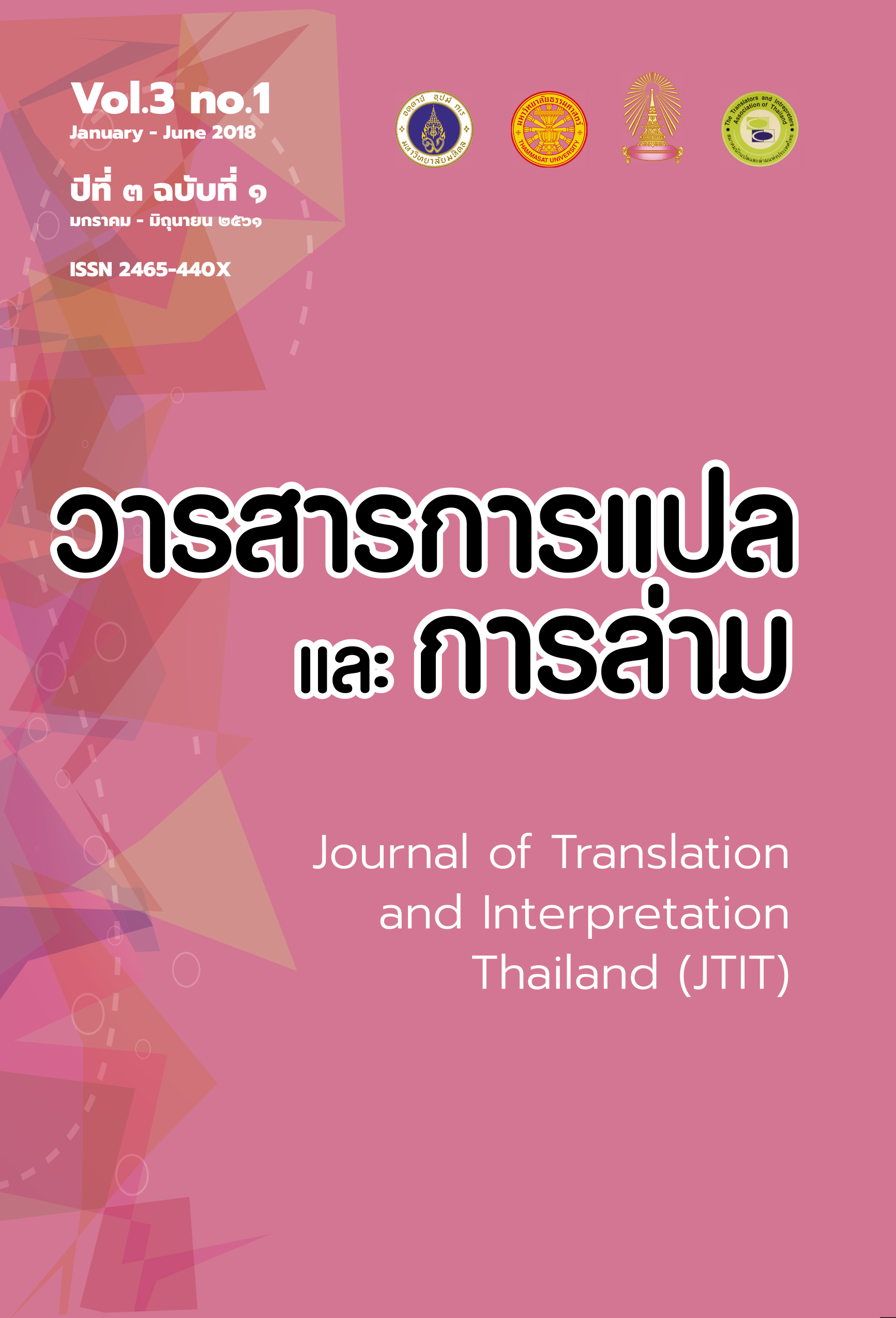การแปลโดยใช้ภาษามุขปาฐะ: กรณีศึกษาภาษาจีนกวางตุ้ง แบบฮ่องกง
Main Article Content
บทคัดย่อ
ภาษามุขปาฐะ (orality) หรือภาษาพูด หมายถึง การสื่อสารของความคิดภายในวัฒนธรรม “โดยไม่ได้ใช้ความรู้ใดๆ เกี่ยวกับการเขียนหรือลายลักษ์อักษรบนกระดาษ” (Ong, 2012, p. 11) ซึ่งเป็นมโนทัศน์ที่มักจะอยู่ตรงข้ามกับแนวคิดเรื่องภาษาอ่านและเขียน (literacy) มีการสร้างสรรค์ถ้อยค าผ่านการแสดงเพื่อใช้ในการจดจ าและส่งต่อจากประเพณีการบอกเล่าในบริบทของศาสตร์การแปลนั้น โดยมากแล้วข้อวิพากษ์จะเป็นเรื่องวิธีการคงลักษณะเฉพาะของภาษามุขปาฐะไว้ในบทแปลซึ่งใช้ภาษาเขียน อย่างไรก็ตาม งานวิจัยชิ้นนี้ได้น าเสนอหัวข้อในอีกแง่มุม กล่าวคือ การแปลตัวบทโดยใช้ภาษาพูดที่อยู่ในรูปแบบของภาษาเขียน จากการศึกษาของวอลเตอร์ อง (2012) เรื่องมโนทัศน์ของ ‘มุขปาฐะระดับทุติยภูมิ’ (secondary orality) และ ‘จิตวิทยาพลวัตรของมุขปาฐะ’ (psychodynamics of orality) ผู้วิจัยได้ใช้ภาษาจีนกวางตุ้งแบบฮ่องกงเป็นกรณีศึกษา เพื่อศึกษาการเปลี่ยนแปลงของภาษาที่เกิดขึ้นในระหว่างกระบวนการแปล การแปลโดยใช้ภาษาพูดมีวัตถุประสงค์เพื่อศึกษาคุณสมบัติของความหมายในตัวบทต้นฉบับ ด้วยกลวิธีการใช้ลักษณะเฉพาะของภาษาพูดที่สะท้อนให้เห็นถึงสภาพสังคมในปัจจุบันของกลุ่มผู้อ่านเป้าหมาย ซึ่งจะแตกต่างจากบทแปลมุขปาฐะที่มีจุดประสงค์เพื่อสร้างข้อมูลถาวรและสามารถคงลักษณะของภาษาพูดหรือการแสดงเอาไว้เช่นเดิม แม้ว่าบทแปลที่ได้จะมีสภาพชั่วคราว แต่ก็เชื้อเชิญให้ผู้อ่าน ‘แสดง’ บทบาทการอ่านและเสริมสร้างการตระหนักรู้เกี่ยวกับอัตลักษณ์ทางวัฒนธรรมผ่านการมีส่วนร่วมของผู้อ่านด้วยเช่นกัน
Article Details
เอกสารอ้างอิง
Bandia, P. (2011). Orality and translation. In Handbook of Translation Studies (Vol. 2) (pp. 108-112). Amsterdam: John Benjamins.
Bandia, P. (2015). Introduction: Orality and translation. Translation Studies, 8(2), 156-174.
Basic Law of the HKSAR (Hong Kong Special Administrative Region) of the People’s Republic of China (Cap. 1). (1997). Census and Statistics Department, Government of HKSAR. (2012, February 21). Summary results of 2011 population census announced. Retrieved Jan 1, 2014, from https://www.censtatd.gov.hk/press_release/pressReleaseDetail.jsp?charsetID=1&pressRID=2898
Census and Statistics Department, Government of HKSAR. (2017, February 27). Summary results of 2016 population by-census. Retrieved Sept 21, 2018, from https://www.statistics.gov.hk/pub/B11200942016XXXXB0100.pdf
Chan, P. F., & Wai-hung, N. (1998). 生活粵語本字趣談 (Etymology of Cantonese words in daily use). Hong Kong: Chunghwa Books. Cheung, M. P.Y. (2005). General preface. In 難得糊塗 (Jane Lai drama translation series: The comedy of errors by William Shakespeare), v-vii. (J. Lai., Trans.). Hong Kong: Centre of
Translation, HKBU, and International Association of Theatre Critics (HK).
Chin, W. (2010). 中文起義: 語文保育 (Chinese language uprising: language preservation). Hong Kong: Enrich and Hong Kong Economic Journal.
Crystal, D. (2003). The Cambridge encyclopedia of the English language (2nd ed.). Cambridge: Cambridge University Press.
Cummings, W. (2003). Rethinking the imbrication of orality and literacy: Historical discourse in early modern Makassar. The Journal of Asian Studies, 62(2), 531-551.
De Vries, L. (2015). Views of orality and the translation of the bible. Translation Studies, 8(2), 141-155.
Dialect. (n.d.). In Encyclopaedia Britannica online. Retrieved from https://www.britannica.com/topic/dialect
Edwards, V., & Sienkewicz, J. (1990). Oral cultures past and present. Cambridge, Mass.: Basil Blackwell.
Federici, F. M. (2009). Introduction: New questions for an old debate. Translating Regionalised Voices in Audiovisuals, 15-26. Roma: Aracne.
Fraser, R. (2008). Book history through postcolonial eyes: Rewriting the script. London: Routledge.
Goody, J. (2000). The owner of the written tradition. Washington: Smithsonian Institution Press.
Hutton, C., & Bolton, K. (2005). Preface. In A dictionary of Cantonese slang: The languages of Hong Kong movies, street gangs and city life (ix-xx). Honolulu: University of Hawaii Press.
Lai, J. C. C., & Cheung, M. P.Y. (2005). 黎翠珍與張佩瑤翻譯對談 (Jane Lai and Martha Cheung: a dialogue on translation). In 搖搖一生 (Jane Lai drama translation series: Rockaby by Samuel Beckett), 19-83. (J. Lai, Trans.). Hong Kong: Centre of Translation, HKBU, and International Association of Theatre Critics (HK).
Lee, K. K. G. (2010). Why bother? – Subtitling into Cantonese. Proceedings of The First International Conference on Translation and Interpretation (pp. 248-253). Bangkok: Chulalongkorn University.
Lindsay, J. (2006). Translation and/of/in performance: New connections. In J. Lindsay (Ed.), Between tongues: Translation and/of/in performance in Asia, 1-32. Singapore: Singapore University Press. Makutoane, T. J., Miller-Naudé, C. L., & Naudé, J. A. (2015). Similarity and alterity in translating the orality of the Old Testament in oral cultures. Translation Studies, 8(2), 156-174.
Marrano, M. G., Nadiani, G., & Rundle, C. (Eds.). (2009). Special issue: The translation of dialects in multimedia. inTRAlinea. Retrieved June 5, 2015, from http://www.intralinea.org/archive/article/1720 Matthews, S., & Yip, V. (2011). Cantonese: A comprehensive grammar (2nd ed.). London: Routledge. Nadiani, G., & Rundle, C. (Eds.). (2012). Special issue: The translation of dialects in multimedia II. inTRAlinea. Retrieved June 5, 2015, from http://www.intralinea.org/archive/article/1851
Pang, C. (2009). 廣東俗語正字考 (Tracing the origins of Cantonese colloquial expressions). Hong Kong: Subculture.
Official Languages Ordinance, Basic Law of the HKSAR (Cap 5). (1997). Ong, W. (2012). Orality and literacy: The technologizing of the word (3rd ed.). New York: Routledge.
Orwin, M. (2001). Introduction to Somali poetry. Modern Poetry in Translation, 17, 12-15.
Rosa, A. A. (2015). Translating orality, recreating otherness. Translation Studies, 8(2), 209-225. Shakespeare, W. (1972). The comedy of errors. London: Penguin Books.
Shi, D., Chu, C., & Shao, J. (2006). 港式中文與標準中文的比較 (A comparison of Hong Kong-style Chinese and standard Chinese). Hong Kong: Hong Kong Educational Publishing.
Snow, D. (2004). Cantonese as written language: The growth of a written Chinese vernacular. Hong Kong: Hong Kong University Press.
Wishnia, K. (1995). “A different kind of hell”: Orality, multilingualism, and American Yiddish in the translation of Sholem Aleichem’s Mister Boym in Klozet. AJS Review, 20(2), 333-358.
Zeng, Z. F. (2005). Colloquial Cantonese and Putonghua equivalents (In Chinese and English) (S.K. Lai., Trans.). Hong Kong: Joint Publishing.


